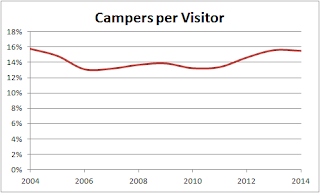 |
| Park Visitors, 2004 - 2014 |

Gas prices and the Canadian dollar have increased in that period, making visits from American tourists less attractive. The slim data available in the 2014 report seems to suggest this has been a factor with the share of US visitors dropping from 11% to 6% between 2006 and 2011 (the only two years where data were available). As well, the number of camping nights per camper has also recently dropped, from around 3.7-3.8 to 3.3. So campers that are still visiting seem to be staying for shorter amounts of time. One would expect this to be independent of factors such as gas prices or the CAD, and guess that perhaps it's possible that those campers who stay longer are the same who come from far away and make a longer holiday out of it. Unfortunately, this is a more recent phenomenon that occurred after the presumed drop in American attendance, with 2012 being the year that seems to be the start of this trend. Are campers not enjoying their stays? Perhaps these are weather related issues? I don't have the data on hand to make a guess.
The number of campers per visitor, which might indicate levels of interest in camping, have stayed pretty steady - a very slight dip in the years between 2005-2012, but recovering back to 2004 levels in 2013, 2014. This suggests that overall interest in camping is steady, and day visitors are continuing to do what they do, with no new motivation to stay the night.
Low attendance and interest can have pretty dire consequences for our park system. I highlight a few parks that have had pretty low visitation rates in my guide to Camping in Ontario. Sadly, some of the parks have recently seen changes in management or have been closed. For example, Mississagi is now operated by the City of Elliot Lake. Obatanga and The Shoals are representative of some gems that are no longer operating. This has resulted in a loss of accessibility to these protected areas, as even low-maintenance interior sites are blocked by closed park entrance gates. Hopefully this is something that will be corrected soon, but with continuing provincial budget deficits, it seems unlikely.
An even worse scenario would be for Ontario Parks to try to lure more campers in through higher-impact activities; the potential exists that, in pursuit of greater appeal, Ontario's parks current peaceful character suffers as a result of a rise in incompatible uses. I have faith in the wisdom of park managers, and hope that this won't be the case. My feeling is that the province of Ontario has undersold the immensity and variety of its park system, focusing more on promoting parks such as Algonquin, Bon Echo and Killarney; meanwhile, beautiful alternatives to these exist that are under-visited (examples include Quetico, Lake Superior and Temagami).
Fortunately some clarity about park interest will be available in 2015 and 2016's data. The Canadian dollar has plummeted in recent years, making it less attractive for Canadians to vacation outside of Canada, and much more attractive for the flow to start coming the other way. It will be interesting to see how this pans out and am interested in hearing your thoughts.

No comments:
Post a Comment